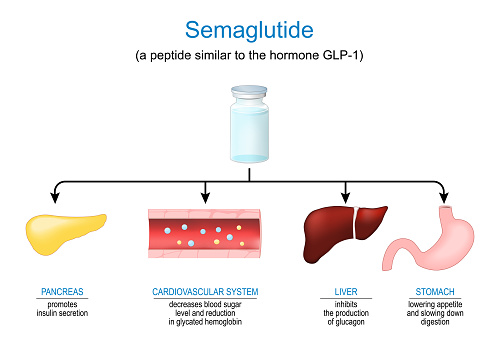Understanding the Differences Between Semaglutide and Tirzepatide

Obesity and type 2 diabetes have seen a dramatic rise, posing significant challenges to global health. These conditions are closely linked to an increased risk of cardiovascular disease, highlighting the importance of effective treatment options. For patients seeking medications that aid in weight loss and improve cardiovascular health, semaglutide and tirzepatide are powerful tools. Complete Cardiology Care helps patients examine the differences between semaglutide and tirzepatide in Sugar Land, TX. We help you understand their mechanisms of action, efficacy, side effects, dosage considerations, and impact on cardiovascular health.
Mechanism of Action
Semaglutide is a glucagon-like peptide-1 (GLP-1) receptor agonist. It mimics the actions of the naturally occurring GLP-1 hormone, which stimulates insulin secretion, reduces appetite, and slows gastric emptying. This combination helps regulate blood sugar levels while promoting weight loss.
Tirzepatide is a dual GLP-1 and glucose-dependent insulinotropic polypeptide (GIP) receptor agonist. By stimulating two hormone pathways, it enhances insulin secretion, more effectively suppresses appetite, and supports a greater reduction in blood sugar levels.
Both medications can reduce cardiovascular risk factors, including improved blood sugar control, weight reduction, and lower blood pressure. Tirzepatide’s dual GIP and GLP-1 activity may provide an additional layer of benefit for heart health due to its enhanced metabolic effects.

Semaglutide vs Tirzepatide: Efficacy
Clinical studies indicate both medications lead to significant weight loss. Tirzepatide has consistently demonstrated a slightly higher effectiveness in overall weight loss. In some studies, tirzepatide achieved up to 20% body weight reduction, while semaglutide users averaged around 15%.
Studies analyzing cardiovascular improvements suggest that both medications reduce risk factors associated with heart disease, such as high blood pressure and cholesterol levels. Preliminary data hints at tirzepatide’s additional benefits due to its dual-receptor approach. Though both medications are effective in treating obesity and type 2 diabetes, tirzepatide appears to offer a slight advantage in terms of weight loss and cardiovascular improvements.
Semaglutide vs Tirzepatide Side Effects
Semaglutide and tirzepatide both commonly cause gastrointestinal system side effects. Both medications cause slow gastric emptying, which can cause vomiting, nausea, and digestive discomfort. Some patients taking semaglutide experience more pronounced side effects due to its sole GLP-1 action. While these side effects rarely impact cardiovascular health directly, discomfort during treatment may influence patient adherence.
Tirzepatide vs Semaglutide Dosage
Partnering with a certified healthcare provider for appropriate dosage management is key. Semaglutide typically begins with a dosage of 0.25 mg per week, progressively increasing to 2.4 mg per week for weight reduction, adjusting every four weeks to limit adverse effects. Tirzepatide generally starts at 2.5 mg per week and can augment to 15 mg. Higher tirzepatide dosages can amplify weight loss and glucose regulation, but supervised titration by a certified medical professional is essential to prevent severe reactions.
Washout Period Between Semaglutide and Tirzepatide
A washout period refers to the time required to clear one medication from the body before starting another similar treatment. This prevents potential overlapping effects that could lead to adverse outcomes. We typically recommend a washout period of at least two to four weeks when switching between semaglutide and tirzepatide. This allows sufficient time for one medication to leave the system and reduces the risk of exacerbated side effects. Adhering to the washout period is essential for cardiovascular safety, avoiding risks such as compounded blood sugar decreases or excessive gastrointestinal stress.
Weight Loss and Cardiovascular Health
Weight loss can improve blood pressure, cholesterol, and overall cardiovascular function. Semaglutide and tirzepatide provide substantial weight loss benefits, directly contributing to better heart health. Tirzepatide’s dual hormone targeting gives it an edge in weight reduction. This enhanced efficacy may translate to even more significant cardiovascular benefits over time. Sustained weight loss achieved by either drug could reduce the risk of heart disease, stroke, and other cardiovascular complications.
Patient Considerations
Complete Cardiology Care customizes each patient’s weight loss care. We consider the cost, side effects, and weight loss goals to determine the best medication for you. We believe the choice between semaglutide and tirzepatide hinges on individual patient needs, medical history, and level of comfort with side effects. Effective guidance from our healthcare professionals ensures medications are tailored to meet personalized goals, balancing weight management with cardiovascular health.
Call Us to Boost Your Heart Health
Semaglutide and tirzepatide represent front-line options in the fight against obesity and type 2 diabetes. While trezepatide shows a slight edge in weight loss and potential cardiovascular benefits, the choice ultimately depends on individual patient needs. For more information and to schedule a consultation with us, get in touch with Complete Cardiology Care.
